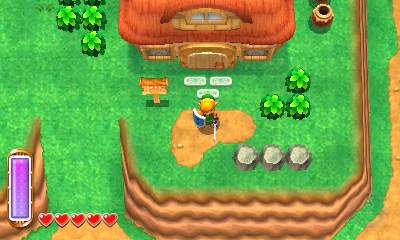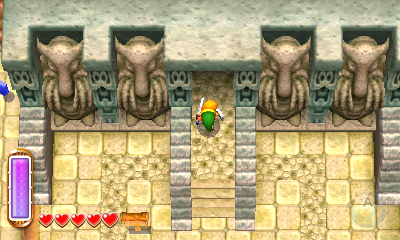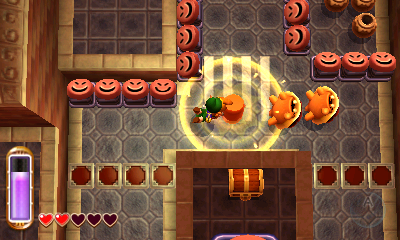How do I even begin to describe a game that parallels the legendary The Legend of Zelda: A Link to the Past? For many gamers, A Link to the Past is the quintessential Zelda experience, a game that is simply unrivaled within its genre and its series. The very idea that Nintendo would attempt to create a sequel, spiritual or otherwise, to such a classic is practically sacrilegious in some circles, and I must admit that even I viewed the premiere trailer with all the skepticism I typically possess (although there was some adrenaline-fueled, heart-racing excitement rushing through my veins along with that skepticism. I mean, we are talking about Zelda here).
I had to zigzag through waves of Nintendo fans, who are a frantic and crazed bunch, to reach the PR rep who held this game. Use whatever similes you want—winning the lottery, striking gold, whatever—none will describe how lucky I am to have had the opportunity to try it. So…you’re welcome.
Oh, and it’s good, too.
The Legend of Zelda: A Link Between Worlds is instantly familiar to those who have played A Link to the Past. The demo began outside Link’s house, at least what was Link’s house in A Link to the Past. The surrounding area—the castle gate, the tree placement, those little cinnamon roll-shaped hills—are all taken directly from A Link to the Past. In fact, the map and general layout of the game are lifted directly from its predecessor.
The demo only allowed me to travel east, to the first dungeon, but I came equipped with the Master Sword, bombs, a fire rod, and arrows. While the map is lifted from the original, the dungeons are completely different. Inside, I used the hammer to smash down several blocks, plus a few of those familiar turtle baddies, which then sprung me up to the next floor of the dungeon. This is one of many differences between A Link to the Past and A Link Between Worlds. The 3D is used to great effect here to show Link jumping from floor to floor. You can clearly see and feel the depth when it occurs, and it’s satisfying to watch. It’s one of the few instances I can claim in which I enjoyed a game’s 3D. I typically shut it off because it gives me a killer headache, but it works well here without being overbearing, and I can see myself playing the game with it on.
Regardless of whether or not you use the 3D effect, A Link Between Worlds feels significantly less flat than A Link to the Past. And while the graphical overhaul is somewhat cartoony, it still perfectly emulates its source material, most likely due to its vibrant color palette. I was unable to hear the music on the show floor, but from the trailer, it sounds as though we’ll be treated to faithful arrangements of classic Zelda themes from A Link to the Past.
Speaking of flat things, though, Link can also morph into a drawing and walk along walls on a 2D plane. The mechanic is seamless: approach the wall and hit A, and he’ll instantly transform. Link can stay in this form as long as his magic meter isn’t empty. It automatically recharges in his human form. This mechanic is used to navigate environmental puzzles, and I assume it will be utilized in boss battles in some form.
It’s an interesting twist on the classic Link to the Past gameplay because it forces you to think about how to travel from Point A to Point B on a plane you can’t always readily see. One puzzle in the first dungeon forced Link to ride a moving platform while navigating obstacles directly in his path. Link rides the platform in top-down view, but the camera shifts to a side view when you change into a drawing. This particular puzzle wasn’t a challenge, but I can already see how complex these puzzles could become in the later levels.
A Link Between Worlds also handles secondary weapons and items differently. No longer does Link carry a separate supply of bombs, arrows, and magic. All these weapons are now tied to the aforementioned magic meter, and each weapon uses a different amount. An arrow takes less magic than a bomb, for instance, and again, the meter refills when none of your actions take from it. I’m on the fence about this particular choice, but I wonder if it really makes that much of a difference from A Link to the Past. There’s also the possibility that it could make sections of the game harder if a specific weapon uses a sizeable amount of your meter. Skill might factor more heavily into the use of such weapons, since the magic meter would undoubtedly influence your actions. Of course, that’s just speculation on my part at this time.

The Legend of Zelda: A Link Between Worlds straddles a fine line between the past and the present. It’s undeniably A Link to the Past, but it includes enough new features that even gamers who haven’t experienced the classic (for shame) should be excited. While it remains to be seen if it can ultimately live up to or exceed its predecessor’s accolades, it’s off to an impressive start. Few details exist about the game’s story, aside from it somehow taking place in the Link to the Past timeline. I’m excited to see how deep the connection between the two games will run when the game is released for the 3DS this November.










